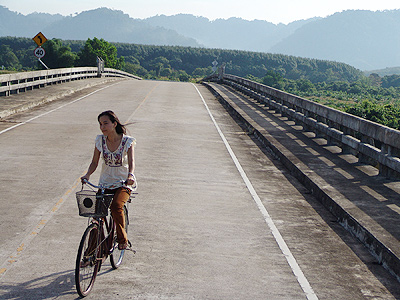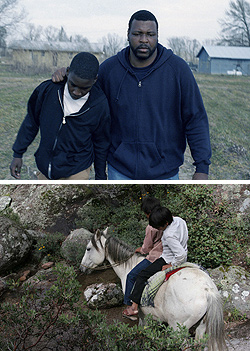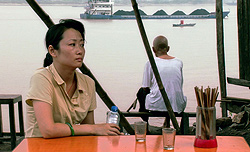Berkeleyan
 |
Wonderful Town, left, was among the exemplary first features honored at this year’s international film festival in Rotterdam. |
Sights, sounds, and stories from around the world
PFA curator Susan Oxtoby shares her picks from the San Francisco International Film Festival
![]()
| 16 April 2008
| SFIFF @ PFA: The details Festival tickets, priced at $12.50 general admission or $10 BAM/PFA and San Francisco Film Society members, are available by phone at 642-5249. Advance tickets for PFA screenings only are sold at the Berkeley Art Museum admission desk (2626 Bancroft Way, 11 a.m. to 5 p.m.) and at the PFA Theater box office (starting one hour before the first show of the day). PFA tickets can also be purchased online at bampfa.berkeley.edu up to one day before the program, for pickup at will-call. Tickets for all festival venues, along with information about purchasing non-PFA tickets in person or by phone, are available from the festival website, www.sffs.org. |
Although T.S. Eliot proclaimed April the cruelest month, Bay Area cinephiles may beg to differ.
Springtime signals the arrival of the San Francisco International Film Festival, which has served up a banquet of global film for 51 years. Among the festival’s venues is the campus’s Pacific Film Archive, whose senior film curator, Susan Oxtoby, personally chooses the works that will screen there — 36 of the festival’s 100-plus invited films this year.
Even for ambitious filmgoers, culling a manageable list of must-sees during the festival fortnight (April 24 through May 8) can be a difficult task. Below is a guide to some of Oxtoby’s selections from among the dizzying choices.
With The Romance of Astrea and Celadon (France, 2007), director Eric Rohmer shifts his focus from modern romance — a topic he’s treated in many films — back to a classical love story. For what may be his final film, the 87-year-old filmmaker found inspiration in a 17th-century text (set in fifth-century Gaul). Celadon, a young shepherd, and lovely Astrea are star-crossed lovers whose story plays out against a backdrop of nymphs, druids, and angels. In his charmingly anachronistic tale, Rohmer demonstrates that romantic misunderstandings, entanglement, and desire are timeless. “It feels like you’re watching classical drama in the wilder-ness. It stands apart,” says Oxtoby. The film’s male lead, Andy Gillet, is expected to be present at the film’s PFA screening. Tuesday, April 29, 6:30 p.m.
Because avant-garde programming is one of the PFA’s strengths, each year curator Kathy Geritz and Irina Leimbacher, an independent film curator, assemble a program of experimental films for the festival. This year’s program, “In a Lonely Place: New Experimental Cinema,” homes in on life’s small, poignant moments. Among its seven shorts is Woodward Gardens, directed by a local filmmaker, Katherin McInnis. Tuesday, April 29, 8:45 p.m.
Set in an unnamed African country and inspired by the conflict in Sierra Leone, Ezra (Nigeria/France/Austria, 2007) offers a fictional view of a situation that’s all too real: An estimated 120,000 children on that continent have been engaged as soldiers in armed conflict. Instead of focusing on battle scenes, Nigerian-born filmmaker Newton Aduaka, whose family survived the Biafran War of the late 1960s, paints a psychological portrait of the war’s survivors. While African films typically center on charming family stories, says Oxtoby, Ezra “has got an edge to it. It’s extremely powerful, and very well-made.” Thursday, May 1, 6:30 p.m.
 Festivalgoers can travel from the Mississippi Delta in Ballast, top, to the remote mountains of Mexico in Cochochi, bottom. |
In addition to presenting films from around the globe, the San Francisco International Film Festival also screens documentaries and narrative features by first-time directors. Oxtoby singles out two films in the latter category: Ballast (USA, 2007), directed by Lance Hammer, who won the directing and cinematography awards at the 2008 Sundance Film Festival, and Cochochi (Mexico/England/Canada, 2007), directed by Israel Cárdenas and Laura Amelia Guzmán.
Set in the Mississippi Delta, Ballast is about the ripple effects of a suicide on a man, a woman, and a child in a small town. Hammer was drawn to the Delta’s beauty and sadness, and wished to communicate those emotions through his film’s tone, images, and the narrative itself. To convey an authenticity of place, he employed a cast of nonprofessional actors and rehearsed with them for several months before shooting to incorporate their idioms and expressions into the story. Oxtoby describes Ballast as “well-acted and intelligently directed, and powerful and gripping in a very understated way.” Friday, May 2, 6:30 p.m.
Films that offer a lens on people living in remote locales are one reason to go to film festivals, says Oxtoby, who enjoyed Cochochi’s “quiet story line and beautiful pacing.” Two preteen Tarahumara brothers whose grandfather asks them to deliver medicine get into trouble when they take his horse without permission, then lose it, disagree on the best route to follow, and ultimately become separated. The tale features indigenous nonprofessional actors and simple camera techniques. Monday, May 5, 6:30 p.m.
 The characters of Jia Zhang-ke’s Still Life, above, are all on quests. |
Jia Zhang-ke, a leading figure of what is known as the Sixth Generation of filmmakers in the People’s Republic of China, directed Still Life (Hong Kong/China, 2006), which won the Golden Lion, the top prize at the Venice Film Festival in 2006. The film traces the changes taking place in Fengjie, a town whose residents are being displaced because of the construction of the enormous Three Gorges Dam. Jia depends on images more than dialogue to convey his ideas. Oxtoby, who says the feature-length narrative has the feel of a documentary, calls Still Life “very fresh.” Tuesday, May 6, 8:45 p.m.
Wonderful Town (Thailand, 2007), a feature film directed by Bangkok native Aditya Assarat, takes place in Takua Pa, near the Andaman Sea coast of southern Thailand, where the 2004 tsunami killed thousands of people. The film is a love story between Ton, an architect from Bangkok who’s come to supervise the reconstruction of a beach hotel, and Na, a young woman whose family runs the establishment. Na’s family and the town’s inhabitants bristle at the romance, at odds with the quiet air of melancholy that clings to the beautiful seaside community three years after the disaster. Oxtoby says Wonderful Town is “a terrific example of the beautiful, lyrical filmmaking” that abounds in Southeast Asia. Wednesday, May 7, 8:45 p.m.

